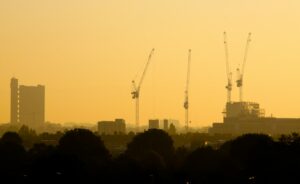New research has found that greenfield housing developments are adding hundreds of thousands of new car journeys to our roads, increasing congestion, carbon emissions, and air pollution.
The new report from Transport for New Homes concludes that a typical greenfield development in England is designed in every way around car use, with as many as two to three car parking spaces per home.
The group visited 20 new housing developments, concluding that the sustainable places that the government and developers envisage for future living have not been delivered, with residents having to drive for nearly every journey in some places.
The research follows the Transport for New Homes flagship report in 2018, finding that new greenfield housing has become even more car-based than when they visited developments three years ago.
In contrast, brownfield developments in cities tended to be less car-based, allowing better access to local amenities by foot, cycle, and public transport.
Jenny Raggett, Project Coordinator at Transport for New Homes, said: ‘We cannot go on as we have been, building many hundreds of thousands of new homes in places which are not only impossible to serve with sustainable transport, but actually promote more and more travel by car. At a time of climate emergency and with a need to cut congestion on our roads, this is not the way we should be building for the future. We have to draw the line and do things differently.
‘Transport and planning shape the way we live. Despite our planners hoping for ‘vibrant places’ where people have many opportunities to interact in real life, the reality seems very different. Small shops, cafes and businesses built for local living are just not there in most new greenfield estates. Local parks, community halls, playing fields and other amenities that would take people away from looking at their screens and encourage them to get out and walk or cycle, appear often not to have materialised. Good public transport often remains aspirational with cuts to services looming. For people who cannot afford a car or cannot drive, they are essentially stuck. This cannot be a healthy vision for how people will live in the future.’
Steve Chambers, Sustainable Transport Campaigner at Transport for New Homes, added: ‘We found that new housing estates do not live up to government aspirations of homes built around walking, cycling and public transport. With rare exceptions, we discovered that newly built homes are creating thousands of car-dependent households, with poor use of land and tiny gardens to accommodate two or three parking spaces per dwelling.
‘Proposals for housing as part of the Levelling Up White Paper will produce more of the same without a dramatic change in approach to planning. Housing must be mixed with, or built close to, amenities and jobs to make active travel a reality for short trips, and good quality public transport provided as soon as the first residents move in.’
In related news, Steve Chambers, an urban planning and sustainable transport consultant, lecturer and campaigner, speaks to NewStart about the impact of car dependency on planning for new housing developments, and how this problem can be addressed for a more sustainable future.
Photo by Sarah Brown

















Leave a Reply